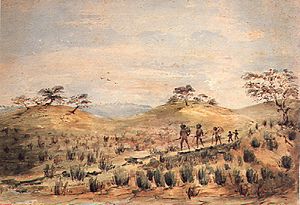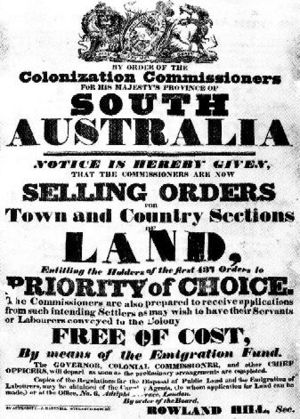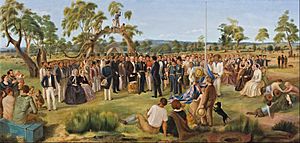History of South Australia facts for kids
The history of South Australia tells the story of this Australian state, from its very beginnings. Long before Europeans arrived, Indigenous Australians lived here for thousands of years. Then, in the 1800s, British colonists came to set up a new kind of colony – one without convicts.
In 1834, the South Australia Act, 1834 created the Province of South Australia. It was planned to be a "free colony," meaning no convicts were sent there. After some tough times, the British government took more control. But by 1857, South Australia became a self-governing colony with its own Parliament.
During this time, brave explorers ventured into the land. They found some good farming areas, but also vast deserts. Farmers brought in sheep and other animals. They grew wheat and started a successful wine industry. Important minerals like copper were also discovered. German families, seeking freedom, settled in places like the Barossa Valley and helped develop the wine industry.
South Australia became known for its new ideas in government and land ownership. It was the first place in the world to use the Torrens title system for land registration in 1858. Women in South Australia were also among the first in the world to get the right to vote in the 1890s. In 1901, South Australia joined the other British colonies to form the Commonwealth of Australia. Even though it has a smaller population, South Australia has often led the way in social and political changes in Australia.
After World War II, many refugees and new migrants came to South Australia. This helped the population grow and made the state more multicultural.
Contents
Ancient History: Aboriginal Settlement
The first people to live in the area we now call South Australia were Aboriginal Australians. Their ancestors arrived in northern Australia about 40,000 to 60,000 years ago. They travelled south and eventually lived in all parts of Australia, including what would become South Australia.
We have proof of human activity in South Australia from over 65,000 years ago. There are special ceremonial sites and rock art in the Flinders Ranges. People also mined flint and created rock art in the Koonalda Cave on the Nullarbor Plain. Wooden spears and tools have been found in the South East, in an area now covered by peat bogs. Kangaroo Island was also home to people long before rising sea levels separated it from the mainland.
Just before the British arrived, many different Aboriginal societies and language groups lived in South Australia. Two main cultural groups were the "Lakes Group" and the "Western Desert group." The "Lakes Group" lived north of the Mount Lofty Ranges, up to Lake Eyre, and across the Eyre Peninsula. They spoke similar languages, called Thura-Yura languages, and shared rituals.
The "Western Desert group" lived (and still live) north and west of Lake Eyre, and west of the Eyre Peninsula. This group extends far into Western Australia and the Northern Territory. They speak very similar languages, like Pitjantjatjara and Yankunytjatjara, which are still strong today. Other groups lived along the Murray River, including the Ngarrindjeri people of the Coorong and Lake Alexandrina areas.
European Explorers Discover the Coast
The first time Europeans saw the South Australian coast was in 1627. A Dutch ship called t Gulden Zeepaerdt (The Golden Seahorse), led by François Thijssen, explored the coastline. Thijssen named the land "Pieter Nuyts Land."
In 1801-02, Matthew Flinders led the first journey around Australia on his ship, the HMS Investigator. At the same time, French Captain Nicolas Baudin was also mapping the southern coast with his ships, the Géographe and the Naturaliste.
Even though France and Britain were at war, the two expeditions met peacefully at Encounter Bay. This bay is south-east of the Fleurieu Peninsula. Baudin called the land "Terre Napoléon" and named the Fleurieu Peninsula after a French explorer. In 1802, Flinders named Mount Lofty, but he didn't record much about the area that is now Adelaide.
Charles Sturt led an expedition from New South Wales in 1829. He followed the Murrumbidgee River to a "broad and noble river," which he named the Murray River. His group followed the Murray to where it met the Darling River, and then continued to Lake Alexandrina, where the Murray meets the sea. The journey back upstream was very difficult.
Britain Prepares for a New Colony
A group in Britain, led by Edward Gibbon Wakefield, wanted to start a colony based on free settlers, not convict labour. Wakefield had a unique idea: land should be sold, not given away for free. The money from land sales would then be used to pay for skilled workers to travel to the colony for free. This way, the colony would have enough workers, and they would be responsible people, not paupers or convicts.
In 1830, Charles Sturt explored the Murray River. He was very impressed with the land between Lake Alexandrina and St Vincent Gulf. He wrote that he had "never fell on a country of more promising aspect."
Captain Collet Barker explored the area more thoroughly in 1831. Sadly, after swimming across the Murray Mouth, Barker was killed by local Aboriginal people. Despite this, Barker's detailed survey helped Sturt decide that the eastern shore of St Vincent's Gulf was a perfect spot for a new colony.
The South Australian Association
In 1834, the South Australian Association convinced the British Parliament to pass the South Australia Act, 1834. This Act set aside a huge area of 802,511 square kilometres for the new colony. It also made sure the colony would be convict-free. The plan was for South Australia to be a perfect British society, with no religious discrimination or unemployment.
The Act said that £20,000 had to be raised and £35,000 worth of land sold before settlement could begin. These conditions were met by the end of 1835. Unlike other colonies that started with convicts, South Australia's founders wanted a place with political and religious freedoms. The South Australia Act also promised a representative government once the population reached 50,000.
South Australia was the only colony created by an Act of Parliament. It was meant to cost the British government nothing. Convicts were forbidden, and poor migrants who received help to travel had to bring their families. Importantly, the 1836 document that officially started the colony included a promise to protect the rights of Aboriginal people to the lands they lived on.
The colony's borders were set between 132° and 141° East, and north to the Tropic of Capricorn. These borders were chosen because they matched the coastline first mapped by Matthew Flinders in 1802. In 1836, the ships John Pirie and Duke of York sailed to South Australia to set up the first settlement on Kangaroo Island.
The Proclamation of South Australia (1836)
Quick facts for kids Province of South Australia |
|||||||||||
|---|---|---|---|---|---|---|---|---|---|---|---|
| British Crown Colony | |||||||||||
| 1834–1901 | |||||||||||
| Government | |||||||||||
| • Type | Self-governing colony | ||||||||||
| Monarch | |||||||||||
|
• 1834-1837
|
William IV first | ||||||||||
|
• 1837-1901
|
Victoria last | ||||||||||
| Governor | |||||||||||
|
• 1836-1838
|
John Hindmarsh first | ||||||||||
|
• 1899-1901
|
Hallam Tennysonlast | ||||||||||
| History | |||||||||||
|
• independence from the New South Wales colony
|
1834 | ||||||||||
| 1901 | |||||||||||
|
|||||||||||

Royal Navy Rear-Admiral John Hindmarsh was chosen as South Australia's first governor. The first settlers and officials sailed in early 1836. Nine ships, carrying 636 people, left London for South Australia. These included the Cygnet (with Colonel William Light's surveyors), Africaine, Tam O'Shanter, Rapid, and HMS Buffalo (with Governor Hindmarsh).
After an eight-month journey, most ships took supplies and settlers to Kangaroo Island. They landed at Kingscote and waited for a decision on where the main colony would be.
Surveyor Colonel William Light had two months to find the best spot for the main colony. He needed a place with a harbour, good farming land, fresh water, easy transport, building materials, and good drainage. Light looked at Kangaroo Island, Port Lincoln, and Encounter Bay, but decided they weren't suitable. He chose the Adelaide plains as the best location.
Most settlers moved from Kangaroo Island to Holdfast Bay. Governor Hindmarsh arrived on 28 December 1836 to officially proclaim the province of South Australia. The Port River was found to be a good harbour, but there was no fresh water nearby.
The River Torrens was discovered to the south. Light and his team then worked to decide the city's exact location and layout. The survey was finished on 11 March 1837. Light's team, despite being poorly paid and equipped, then had to survey a huge amount of rural land. Light, even though he was sick with tuberculosis, managed to survey over 600 square kilometres by June 1838.
In most other colonies, the Governor had almost complete power. But in South Australia, power was split between the Governor and the Resident Commissioner. This was to stop the government from interfering with business or religious freedom. However, this split often led to arguments between Governor Hindmarsh and the Resident Commissioner.
The Colony Grows
Until 1851, the Governor ruled with help from an appointed council. Land development was key to Wakefield's plan. Land laws were very important. Land could be bought at a set price per acre, and unused land could be leased. Money from land sales helped pay for poor settlers to come as skilled workers.
People soon started asking for a government where they could elect their own representatives. From 1843 to 1851, a Legislative Council of seven appointed members governed the colony. By 1851, the colony was trying out a council where some members were elected.
Farming Begins: Sheep, Wheat, and Wine
The first sheep and other livestock in South Australia came from Tasmania. Sheep were also brought overland from New South Wales starting in 1838. The wool industry was very important to South Australia's economy in the early years. Large areas of land were leased by "Squatters" until they were needed for farming. Once the land was surveyed and put up for sale, the Squatters had to buy their land or move on.
Most Squatters bought their land, which made it harder for other farmers to find good, empty land. Farms took longer and cost more to set up than sheep runs. But by 1860, wheat farms stretched from Encounter Bay in the south to Clare in the north.
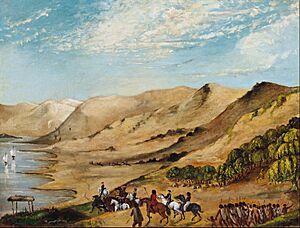
In 1840, the ship Maria was shipwrecked near Cape Jaffa. Sadly, all 25 people on board were killed by Aboriginal people along the Coorong.
The famous wine regions of McLaren Vale and the Barossa Valley were started in the 1840s. Port Pirie was founded in 1845.
Copper was found near Kapunda in 1842. In 1845, even bigger copper deposits were discovered at Burra. This brought a lot of money to Adelaide shopkeepers who invested in the mine. John Ridley invented a reaping machine in 1843, which changed farming methods across South Australia and the country. By 1843, 93 square kilometres of land were growing wheat. By the end of the century, South Australia was known as the "granary of Australia."
When gold was discovered in Victoria in 1851, many workers left Adelaide to seek their fortunes. This caused a severe worker shortage in Adelaide. However, it also created a high demand for South Australian wheat. The situation improved when prospectors returned with their gold.
During the 1850s, over 5,400 hardworking Germans settled in South Australia. Many helped start the wine industry in the Barossa Valley. They also opened the first Lutheran church in Hahndorf.
South Australians wanted to trade with Victoria and New South Wales, but overland travel was too slow. In 1850, the South Australian government offered a £4,000 prize. It was for the first two people to navigate the River Murray in an iron steamboat as far as its meeting point with the Darling River. In 1853, William Randell and Francis Cadell raced each other to Swan Hill, with Cadell winning.

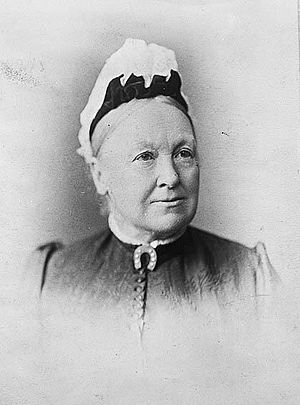
By the mid-1800s, people in Australia's colonies strongly wanted to govern themselves. In 1840, the Adelaide City Council was created, the first city council in Australia. The Australian Colonies Government Act of 1850 was a big step. It gave New South Wales, Victoria, South Australia, and Tasmania the right to create their own representative governments. These colonies eagerly wrote constitutions that led to very democratic parliaments.
In 1855, London gave limited self-government to New South Wales, Victoria, South Australia, and Tasmania. An innovative secret ballot system was introduced in Victoria, Tasmania, and South Australia in 1856. In this system, the government provided voting papers, and voters could choose their candidates in private. This system was adopted worldwide and became known as the "Australian Ballot." Also in 1855, all British men aged 21 or over in South Australia gained the right to vote.
First South Australian Parliament (1857)
South Australia became a self-governing colony in 1856. This happened after the British parliament approved a new constitution. A two-house parliament was elected on 9 March 1857. By this time, 109,917 people lived in the province.
South Australia's 1856 constitution was one of the most democratic in the world. It was even more democratic than other Australian colonies, the United Kingdom, and most European countries at the time. It allowed all adult men to vote (including Indigenous men). It also had secret ballot voting, "one man, one vote," and no property requirements for members of its lower house. There was only a low property requirement for members of its upper house.
In 1877, South Australia was the first part of the British Empire to make Trade Unions legal. In 1891, four United Labor Party candidates were elected to Parliament. They were the first officially supported Labor members in Australia.
More copper was found in 1859 at Wallaroo and in 1861 at Moonta.
South Australia became a safe place for people seeking religious freedom from Europe. German Lutherans set up the important Hermmannsberg Mission in Central Australia in 1870. David Unaipon, who became a preacher and Australia's first Aboriginal author, was born at Point McLeay Mission in South Australia in 1872. He was the son of Australia's first Aboriginal pastor and is now honoured on the Australian $50 note.
Saint Mary MacKillop co-founded the Sisters of St Joseph of the Sacred Heart in rural South Australia in 1866. This was the first religious order started by an Australian. It was dedicated to educating poor children. Mackillop set up schools, orphanages, and welfare centres across the colonies. In 2010, she became the first Australian to be made a saint of the Roman Catholic Church.
During John McDouall Stuart's 1862 journey to Australia's north coast, he found 200,000 square kilometres of grazing land west of Lake Torrens and Lake Eyre. Stuart successfully crossed Central Australia from south to north. His journey mapped out the path later used for the Australian Overland Telegraph Line. South Australia was then given the job of managing the Northern Territory, which used to be part of New South Wales.
In the 1890s, Australia faced a severe economic depression. Banks in Melbourne and Sydney closed. Fewer babies were born, and almost no one immigrated. The value of South Australia's exports almost halved. Drought and poor harvests from 1884 made things worse, and some families even moved to Western Australia. Adelaide wasn't hit as hard as Sydney and Melbourne, and discoveries of silver and lead at Broken Hill helped a little.
In 1861, women who owned property in South Australia could vote in local elections (but not for parliament). However, in 1895, women became able to vote for the Parliament of South Australia. This was the first law in the world that also allowed women to stand for election to political office. In 1897, Catherine Helen Spence became the first female political candidate, though she didn't win. Western Australia gave women voting rights in 1899. By the 1890s, several things were pushing the Australian colonies towards joining together. South Australians voted to join the Commonwealth of Australia.
The 20th Century and Beyond
On 1 January 1901, after a proclamation by Queen Victoria, South Australia stopped being a self-governing colony. It became a state of the Commonwealth of Australia. In 1906, South Australia's first uranium mine opened at Radium Hill. In 1910, the government led by John Verran became the world's first complete Labor party government.
28,000 South Australians volunteered to fight in World War I. After the war, Adelaide had a good period, but then droughts returned, leading to the Great Depression in the 1930s. The state later recovered with strong government leadership. Manufacturing industries helped the state rely less on farming and mining. The 1933 census showed the state's population was 580,949. This was a smaller increase than other states due to South Australia's economic challenges.
After World War II, a program helped 215,000 migrants from many countries come to South Australia between 1947 and 1973. Murray Bridge, once known as Mobilong, got its current name in the 1920s. It is now the fourth largest region in South Australia, after Adelaide, Mount Gambier, and Whyalla.
The 1960s and 1970s saw South Australia introduce several important new laws for Australia. This included the 1966 Prohibition of Discrimination Act, which made it illegal to discriminate based on race, colour, or country of origin.
Construction of the Adelaide Festival Centre began in 1970. South Australia's Sir Robert Helpmann became director of the Adelaide Festival of Arts. The South Australian Film Corporation (SAFC) was started by the Don Dunstan government in 1972. It played a big part in bringing back Australian cinema, with famous films like Picnic at Hanging Rock and Breaker Morant.
In 1976, the Pitjantjatjara Land Rights Act gave the Pitjantjatjara and Yankunytjatjara Aboriginal peoples full ownership of 100,000 square kilometres of their land. In the same year, South Australia appointed the first Aboriginal governor of an Australian state, Sir Douglas Nicholls.
In 1987, copper, gold, and silver production started at the Olympic Dam mine. Olympic Dam also has the world's largest known deposit of uranium.
During the property boom of the 1980s, the State Bank of South Australia grew very fast. But in 1991, the bank collapsed. Labor Premier John Bannon announced that taxpayers would have to rescue the bank due to bad debts. The bank's debt rose to $3 billion. A special investigation was called, and Premier Bannon resigned after giving evidence.
Images for kids
-
Aborigines attack squatters sleeping near Lake Hope
See also
 In Spanish: Historia de Australia Meridional para niños
In Spanish: Historia de Australia Meridional para niños


